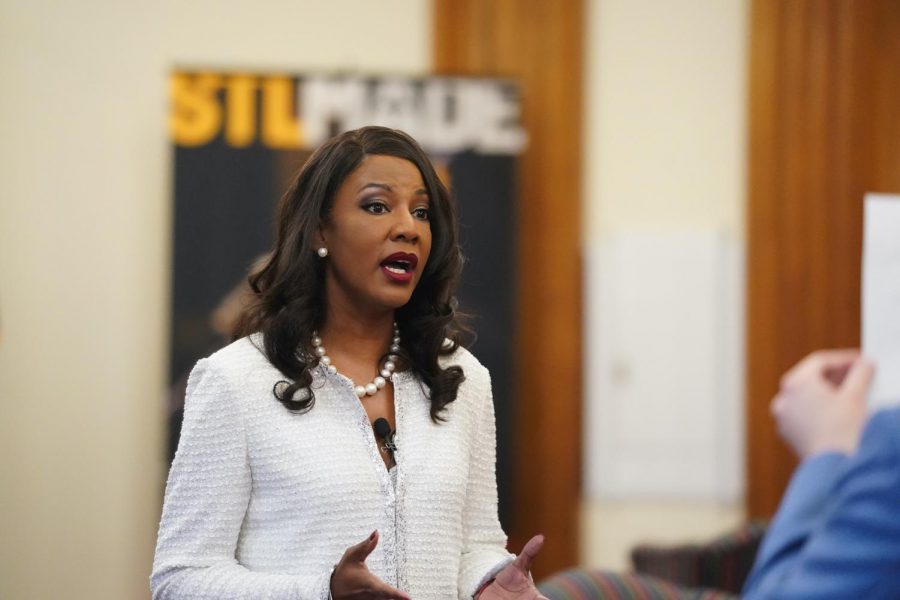Tishaura Jones Makes History
After a close-fought election, Tishaura Jones was sworn-in as St. Louis’ 47th mayor and the City’s first Black female mayor on April 20. Jones plans to bring monumental change to St. Louis city.
St. Louis native Tishaura Jones made history on April 7 by being elected as the city’s first Black female mayor. Jones is a self-described progressive who has worked as a Democratic Committeewoman, has served two terms in the Missouri House of Representatives and was most recently the Treasurer of St. Louis.
SLU senior Savanah Seyer, who has also worked as a staff writer for the University News, is the executive administrator at MO Political, the firm that represented Jones. She worked strategically throughout the campaign to interview the volunteers participating in community outreach, including canvassers, door knockers, phone bank staff and general organizers.
“A lot of people wanted to help out with the campaign, so putting together the right team was something I really took seriously,” Seyer said. “[Jones] just inspires a ton of hope and motivation in a way that I’ve never seen with any other candidate.”
Matt Rauschenbach, the campaign’s political director and spokesperson, said that since the beginning of the campaign, Jones has had three main priorities. The first is public safety. One notable topic is the Workhouse, St. Louis City’s Medium Security Institution which has historically and presently treated inmates inhumanely, largely based on their inability to afford high cash bails. Jones has made a commitment to close the infamous Workhouse within her first hundred days in office.
“She likes to say that public safety is not something we’re going to reform, it’s something we need to transform,” Rauschenbach said.
This campaign objective touches on multiple facets of how our city operates, including how 911 dispatch centers are organized. The overarching goal is to limit the community’s direct exposure to armed officers. People experiencing a mental health crisis would receive a mental health counselor and people experiencing homelessness would receive a case manager.
“I think that’s something really uncomfortable for people to hear, but it’s necessary,” Rauschenbach said.
Her two other priorities are equitable recovery from COVID-19, which includes planning and building public health infrastructure for the next public health crisis, and economic mobility.
“As treasurer, she implemented the college kids program, which gave a college savings account to kindergarteners, and they loaded it with the first $50,” Rauschenbach said. “So, we find programs like this to start breaking down the generational barriers that have held Black people in St. Louis back.”
Part of what made her victory so historic was the new method of voting used by the city, known as approval voting. Approval voting is a non-partisan way to give voters the chance to vote for as many candidates as they’d like, making the single winner the most approved of candidate.
Approval voting is seen by many as a better alternative to the more traditional first-past-the-post system, where voters choose only one candidate and the candidate with the most votes wins, regardless of whether they receive a majority of votes. Approval voting, therefore, opens room for third party challenges and also prevents vote splitting, where one candidate will win a majority of votes in their base areas but will receive little to no support in other parts of the city.
This kind of vote split was seen in the 2017 mayoral race, where Lyda Krewson was narrowly able to clinch the votes, beating Tishaura Jones. Before approval voting went into effect, Krewson won her race by just 888 votes, though that mainly consisted of just the Southwest corridor of the city. Jones won citywide this year, including north of Delmar, despite their voter turnout being substantially lower.
“Cara Spencer, [Jones’ primary opponent], didn’t win any ward north of Delmar, and in most places she didn’t even get north of 20 percent of the electoral votes,” Rauschenbach said. “So this was really the first election, probably for decades, where the winner spanned the entirety of North St. Louis into the central corridor.”
One pitfall, however, was the lack of education their campaign team noticed on this system of voting. According to Rauschenbach, the organizers of Proposition D, which were responsible for this new system, didn’t necessarily do their part in educating the public on how it works. This meant that the obligation mostly fell on the campaigns to make sure voters knew how to utilize it.
Seyer was part of this education process, and was repeatedly motivated by her respect for Jones as a candidate: “She’s not going to tailor her message for someone to make them more comfortable,” Seyer said. “She does not shy away from talking about the real logistics of getting these things done, which is so refreshing.”
Rauschenbach also emphasized how politicians’ language has a real effect on the way issues will be handled moving forward.
“For example, when you talk about something like the City Justice Center downtown, calling it what it is—which is an injustice—sets the tone for the process by which we solve the problem,” Rauschenbach said. “A lot of that trust in the way that we spoke about things came from us just having dialogue around it. Name an issue in St. Louis, and it’s affecting Black and brown communities to an extent that is multiple times the extent to which it affects white people.”
Rauschenbach noted that electing a Black woman as mayor is a powerful moment for St. Louis. In her address at the swearing-in ceremony, Jones acknowledged that she was standing on stone not built for her, in a rotunda that never envisioned her ascent to mayor, working in an office her ancestors could have never dreamed about.
“When a city like St. Louis, where race is so palpable, elects a Black woman [as mayor], it means that it’s ready for progress,” Rauschenbach said. “It’s ready for change. It’s ready for transformation.”
Your donation will support the student journalists of Saint Louis University.




